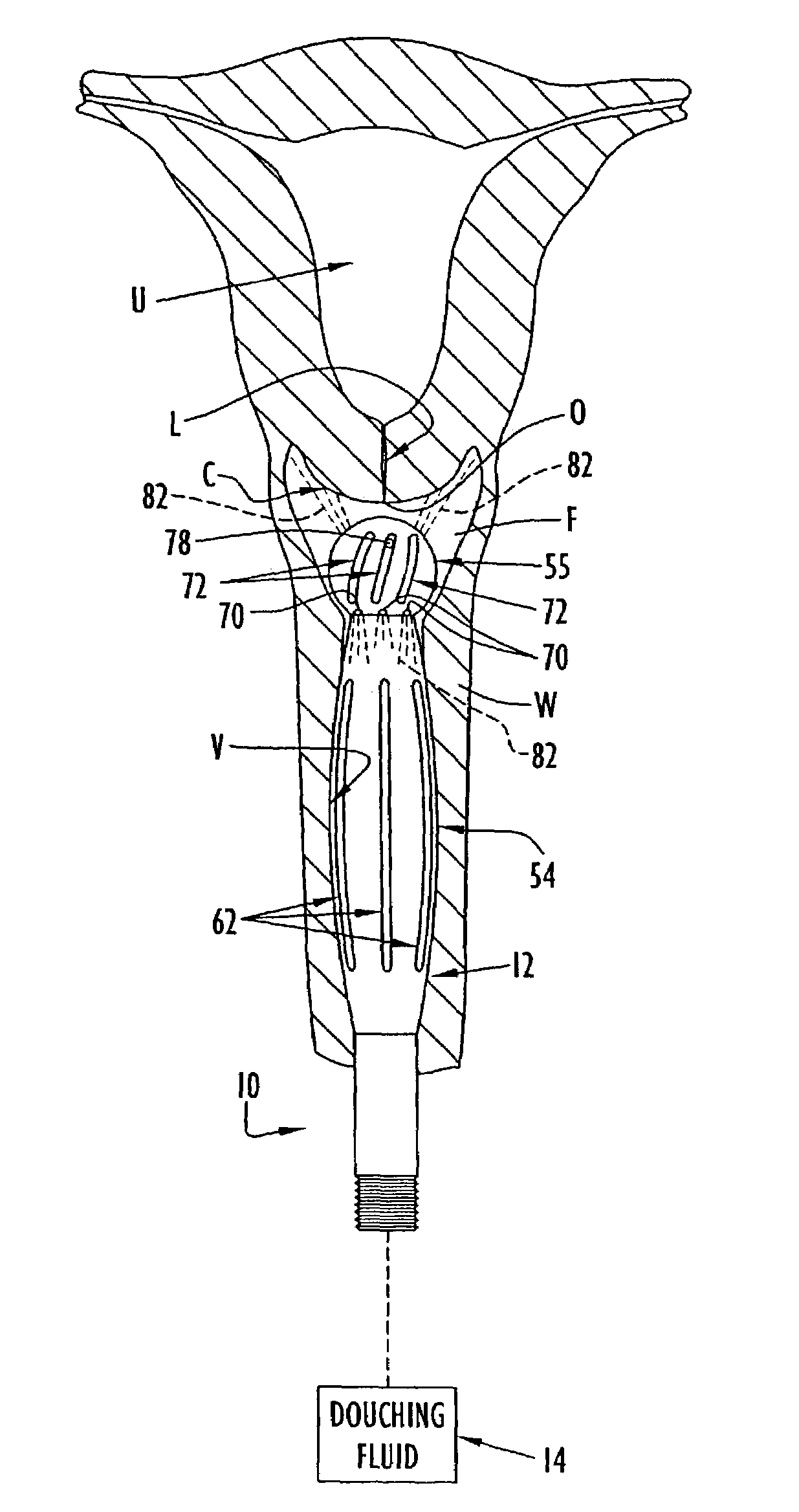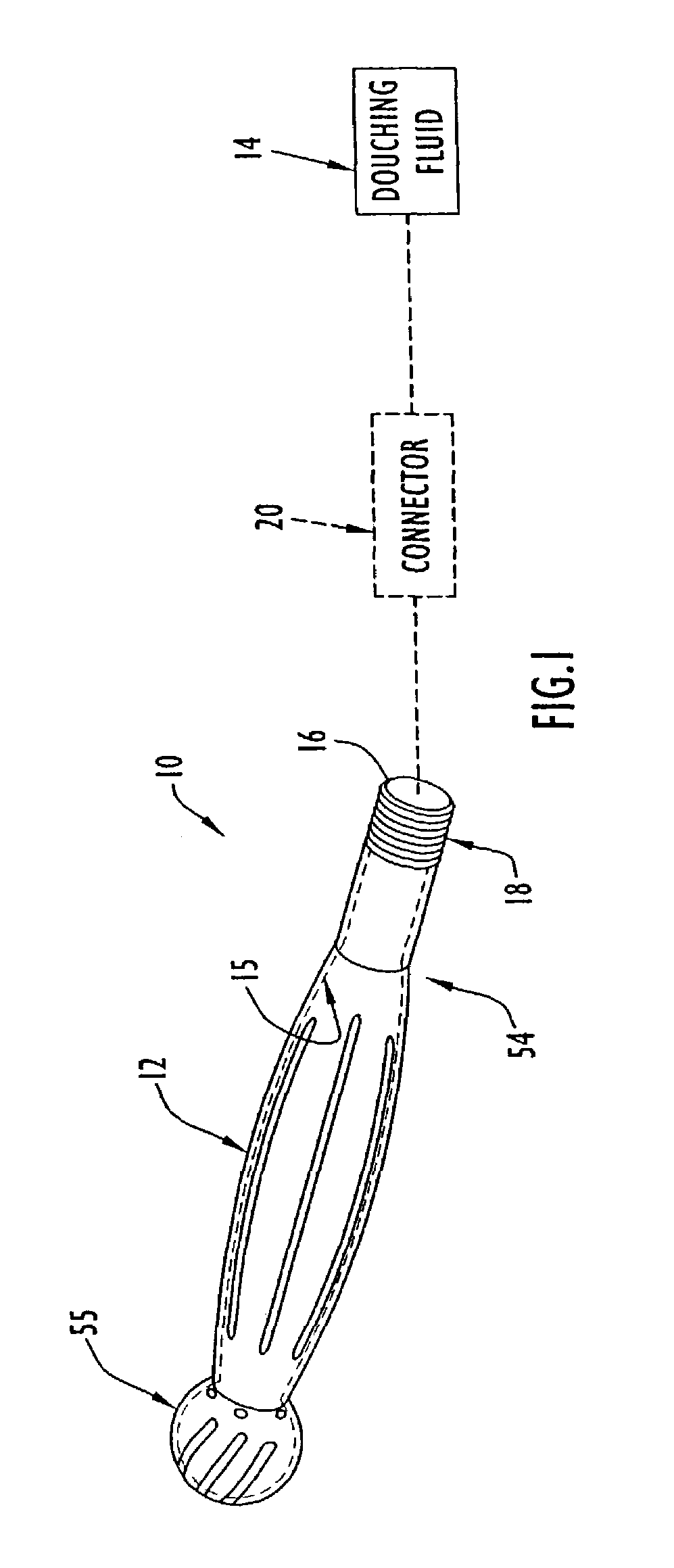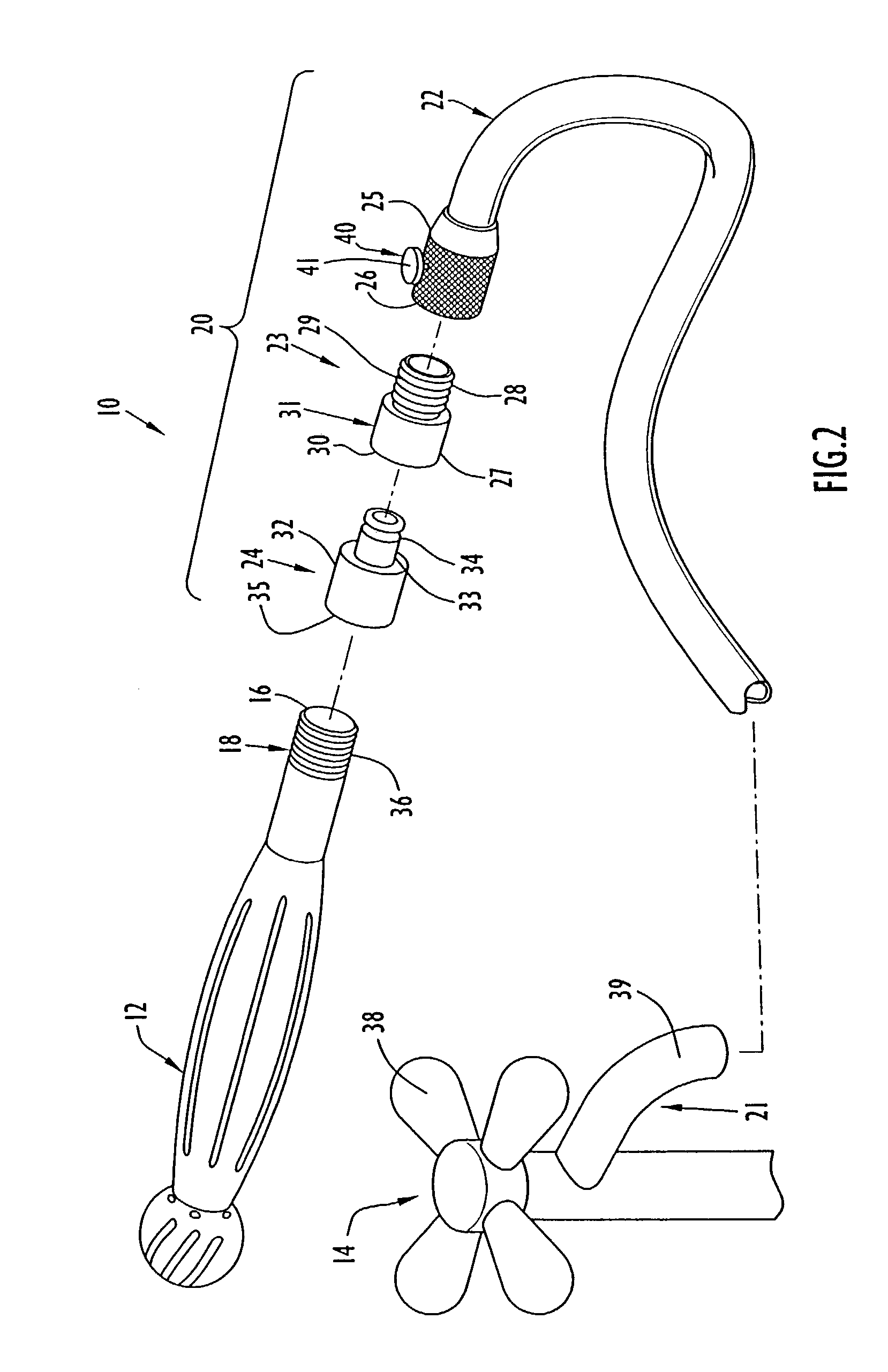Water alone as a douching fluid is not effective at significantly alleviating vaginal odors or the sources of vaginal odors, such as
bacteria, when used in conjunction with
vaginal douche applicators that do not have a stainless steel external surface.
However, commercial douching agents or substances tend not to be effective in alleviating some vaginal odors or may serve merely to temporarily
mask vaginal odors.
Another problem associated with conventional vaginal douches is that the douching agents or substances may cause
irritation in some users and / or tend to alter the normal pH (acid / alkaline) or chemical balance of the vaginal canal.
However, douching fluids consisting of vinegar and water tend not to be effective against vaginal odors for any meaningful length of time.
A further problem associated with conventional vaginal douches is that many
vaginal douche applicators
discharge douching fluid directly at and / or toward the
cervix with sufficient force or pressure so that douching fluid may enter the
cervical canal.
Where douching fluid is not discharged toward the
cervix and the upper portion of the vaginal canal, however, odors will not be eliminated or will quickly return since the cervix as well as the
vaginal tissue produce odoriferous secretions or harbor
odor-producing bacteria.
Hence, failure to wash off the cervix and the upper portion, or fornix, of the vaginal canal will yield an incomplete douching.
An additional problem of conventional vaginal douches relates to the inadequacy of the vaginal douche applicators in maintaining an unobstructed
gravity flow of douching fluid from the vaginal canal.
During douching, trapped douching fluid may build up in the vaginal canal with a sufficient pressure head that the douching fluid is detrimentally forced into and / or through the
cervical canal.
Conventional vaginal douches are also problematic for their failure to limit, regulate or control the flow of douching fluid into the vaginal douche applicators such that the douching fluid is discharged from the applicators at pressures high enough to force the douching fluid into the cervix.
Other drawbacks to conventional vaginal douches are that the vaginal douche applicators are not designed for reuse and are actually unsuitable for reuse due to the difficulties involved in maintaining cleanliness for repeated use.
Accordingly, the presence of bacterial vaginosis has been linked to increased incidences of
cervical cancer and sexually transmitted diseases, and may enable harmful viruses to infect
healthy tissue.
Unfortunately, health care providers and conventional gynecological tests such as
pap smears do not routinely screen for bacterial vaginosis and yeast infections.
Since
semen is alkaline, the normal pH of the vaginal canal increases significantly after coitus and changes from mildly acidic to a more alkaline level such that the normal pH (acid / alkaline) of the vaginal environment is unbalanced or disturbed.
This higher pH promotes a rapid increase in coccoid production and may result in coccoid overgrowth leading to bacterial vaginosis and its various adverse consequences.
Accordingly, post-coital vaginal douching using conventional douches to wash away
semen and / or coccoid bacteria may have some limited benefit in preventing bacterial vaginosis and / or counteracting already existing bacterial vaginosis but has not been shown to reliably prevent and eliminate bacterial vaginosis.
Because of the various problems and limited effectiveness of conventional vaginal douches, vaginal douching has not been widely adopted and used, particularly in the United States, as a preventative and / or treatment for bacterial vaginosis.
Normal
vaginal flora and pH may be disrupted by conventional douches which tend to kill off beneficial lactobacilli and allow overgrowth of harmful bacteria, by poor
hygiene encouraging the overgrowth of harmful bacteria, by
increased pH levels resulting from the presence of
semen, by wearing tight and / or damp clothing and / or by incorrectly treating a vaginal infection with the wrong medication.
Only about 50% of bacterial vaginosis cases are eliminated in response to conventional treatments and even successfully treated cases tend to recur.
Furthermore, conventional antibiotic treatments for bacterial vaginosis may leave patients at
increased risk for fungal infections by over-correcting the vaginal environment.
However, users of conventional anti-fungal products may have their vaginal pH increased too far and may be at increased risk for bacterial infections.
Unfortunately, the various symptoms of vaginal infection are not recognized by most women, and frequently the infection is not accurately diagnosed by doctors.
Too often, healthcare providers and patients incorrectly assume the presence of a yeast infection and seek relief from over-the-counter anti-yeast medication.
Using an incorrect medication can often worsen the actual condition.
Introducing an anti-yeast medication in the absence of a yeast infection results in abnormal
vaginal flora after only one day.
After five days of using the medication, the beneficial lactobacilli are almost totally eliminated, which makes the underlying bacterial infection even more severe.
Conventional douching may benefit vaginal environments that are already undesirably altered or disturbed, but the benefits derived are very limited and may be outweighed by the many disadvantages of conventional douching.
Douching fluids including water, vinegar and / or commercial douche products used with conventional douche applicators fail to properly normalize and stabilize disturbed vaginal environments and either undercorrect or overcorrect for vaginal disturbances.
Conventional douching may temporarily improve one aspect of the vaginal environment while creating imbalances or disturbances in other aspects thereof.
The benefits derived from conventional douching are very short-lived, yet conventional douching performed too frequently is potentially harmful in many respects and may actually greatly exacerbate vaginal disturbances.
Accordingly, conventional douching is unsuitable as a treatment and / or preventative for bacterial vaginosis and yeast infections much less other abnormal biological conditions arising in or affecting the
vagina.
 Login to View More
Login to View More  Login to View More
Login to View More 


